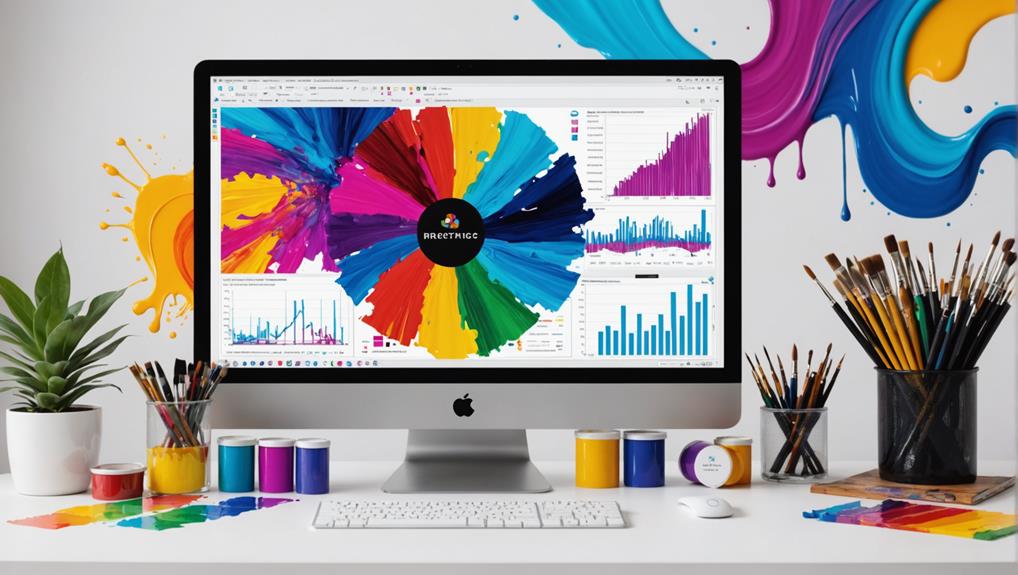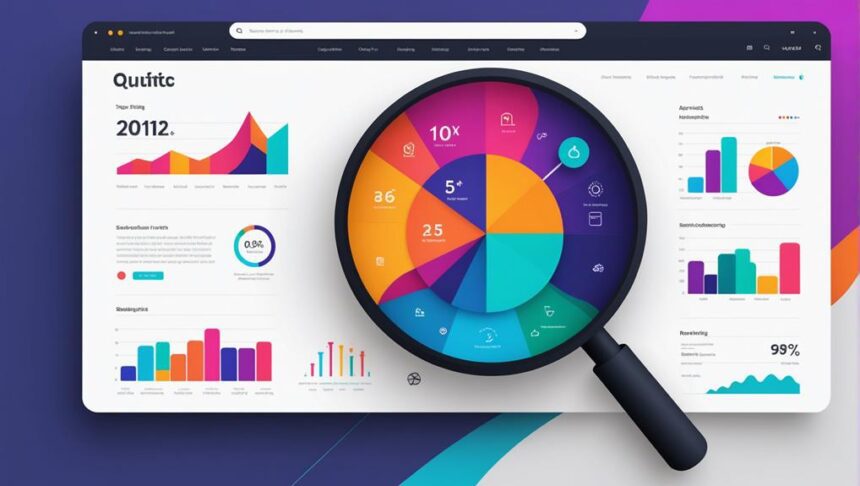Boosting your fluid art website’s SEO involves a cocktail of strategies. Start with keyword research using tools like Google Keyword Planner to find those magical search terms. Make sure your titles and meta descriptions pop with unique, descriptive text, and structure your content with clear headers. Don’t forget to optimize your stunning art images by using descriptive file names and alt text. Regularly update content to keep things fresh. Also, engage on visually-focused social media platforms like Instagram, using relevant hashtags and community interactions to drive traffic. Curious to enhance your art online? Let’s dive deeper into the enchantment of SEO.
Key Takeaways
- Conduct thorough keyword research to identify high-traffic, low-competition terms relevant to fluid art.
- Optimize title tags and meta descriptions with unique, descriptive content to improve search engine indexing.
- Use high-quality images with descriptive file names and alt text to enhance searchability and user experience.
- Create engaging blog posts on fluid art techniques and regularly update content to maintain good SEO performance.
Understanding SEO for Artists
Steering through the intricacies of SEO for artists is essential for enhancing online visibility and attracting a broader audience to fluid art websites.
Let’s explore understanding SEO for artists, starting with keyword research and audience targeting.
Imagine your website as a gallery; you want people to find your masterpieces easily, right? That’s where keyword research comes in. Think of it as figuring out what terms people type into a search engine when they’re looking for art like yours. Tools like Google Keyword Planner can help you discover high-traffic keywords with low competition. This way, you can focus on terms that will bring more visitors to your site.
Now, let’s talk about audience targeting. It’s not just about getting any traffic; it’s about attracting the right crowd. Who are your potential buyers? What are their interests? By understanding your audience, you can tailor your content to their preferences. For example, if your fluid art has a calming effect, use keywords that reflect that mood.
Incorporating these elements into your SEO strategy guarantees that your art reaches the people who will truly appreciate it, boosting both your visibility and engagement.
Optimizing Your Web Pages
Optimizing your web pages is vital for improving search engine rankings and guaranteeing that your fluid art is easily discoverable by potential buyers. Start by conducting thorough keyword research to identify the terms your audience is searching for. Incorporate these keywords into unique title tags and detailed meta descriptions for each page to improve search engine indexing and click-through rates.
Next, focus on structuring your content with a clear page hierarchy. Use header tags like H1, H2, and H3 to organize your information, making it easier for search engines to understand and rank your content. This also enhances readability for visitors, guiding them smoothly through your website.
Don’t forget to optimize images, which are essential for showcasing your fluid art. Use descriptive file names and alt text that accurately describe your pieces. This not only enhances searchability but also improves accessibility for users with visual impairments.
Lastly, keep your website content fresh by regularly updating it. This signals to search engines that your site is active, potentially boosting your rankings. By following these steps, you can guarantee your fluid art website stands out in search results and attracts more visitors.
Crafting Quality Content
Creating quality content for your fluid art website is essential for engaging visitors and boosting your SEO.
Start by writing unique descriptions for each piece, sharing the story behind it, and using high-quality images with proper optimization.
Additionally, consider adding engaging blog posts about your techniques and trends to establish yourself as an authority in the fluid art community.
Unique Art Descriptions
Crafting unique art descriptions is essential for boosting user engagement and improving the SEO performance of your fluid art website. By offering potential buyers insights into the artistic inspiration, techniques, and emotional resonance behind each piece, you can greatly increase the likelihood of purchase. Detailed descriptions not only inform viewers but also improve searchability through relevant keywords.
To create compelling art descriptions, consider the following strategies:
- Describe the Inspiration: Share the story or emotions that inspired your artwork. This adds depth and helps viewers connect on a personal level.
- Detail the Techniques: Explain the methods and materials used, such as the medium, dimensions, and color palette. These specifics not only educate your audience but also enhance SEO.
- Use Sensory Language: Employ vivid, sensory-rich language to paint a picture in the viewer’s mind. This can evoke strong emotional connections and make your art more memorable.
Optimizing your art descriptions with these elements can raise both user engagement and your site’s search engine ranking, helping your fluid art reach a broader audience.
Engaging Blog Posts
By producing high-quality blog posts that explore fluid art techniques and creative processes, you can greatly enhance your website’s visibility and user engagement. Detailed posts that investigate color mixing and pour techniques can captivate your audience and establish your authority in the fluid art niche. Employing effective blogging strategies, such as incorporating relevant keywords and long-tail phrases, can drive more traffic to your site by improving your search engine ranking.
Regularly updating your blog with fresh content is vital for maintaining good SEO performance, as search engines favor websites that consistently offer new information. Sharing your creative journey and the inspiration behind your pieces can emotionally connect with your audience, fostering deeper engagement and encouraging them to share your content. Additionally, including high-quality images and videos within your posts can greatly enhance audience engagement, as visual content is essential for showcasing the unique aspects of fluid art.
Here’s a quick table to help you craft engaging blog posts:
| Blogging Strategy | Description | Benefit |
|---|---|---|
| Detailed Techniques | Explain color mixing and pour methods | Establishes authority |
| Regular Updates | Consistently add new content | Improves SEO performance |
| Emotional Storytelling | Share creative journey and inspirations | Fosters deeper connections |
| Keywords and Phrases | Use relevant search terms | Increases visibility |
| Visual Content | Include high-quality images and videos | Enhances user engagement |
Visual Storytelling Elements
To truly captivate your audience, integrate sensory language and high-quality visuals into your fluid art website, enhancing both emotional connection and engagement.
Crafting a compelling visual narrative starts with vivid descriptions that evoke the senses. Describe the swirling patterns and vibrant hues of your pieces, inviting viewers to imagine the textures and emotions they evoke. This sensory experience can create a profound emotional resonance, making your art more memorable and impactful.
High-quality images are essential. Make sure your photos capture the intricate details and vibrant colors of your fluid art. Optimize these images with descriptive file names and alt text to improve your site’s searchability.
Sharing behind-the-scenes content, such as videos of your creative process, can also add authenticity and invite viewers into your artistic journey.
Creating blog posts that explore the stories behind each piece can greatly boost SEO. Discuss your inspiration, techniques, and the emotional impact you aim to convey, creating a richer experience for your audience.
- Use sensory language: Describe the textures and emotions vividly.
- High-quality visuals: Showcase every detail with optimized images.
- Behind-the-scenes content: Share videos and studio setups.
Employ structured formatting with headings to enhance readability and make your visual storytelling elements more engaging and accessible.
Image Optimization Techniques
Effective image optimization techniques are important for enhancing the SEO of fluid art websites, guaranteeing that images are both search engine friendly and user accessible.
One fundamental aspect is using appropriate image formats. JPEG and WebP are preferred for their balance between quality and file size, which guarantees fast loading times—a critical factor for both SEO and user experience.
Alt text plays an essential role, too. By including descriptive alt text for each image, you provide context to search engines and improve accessibility for visually impaired users. For instance, an image of a vibrant acrylic pour could have alt text like, ‘Bright blue and green fluid art piece with swirling patterns,’ which helps search engines understand the content and boosts your SEO.
Don’t forget to use descriptive file names, such as ‘fluid-art-acrylic-pour.jpg,’ incorporating relevant keywords. This practice aids search engine indexing by making it clear what the image depicts.
Additionally, organizing your images with clear headings and captions that include keywords can greatly enhance user navigation and SEO.
Leveraging Social Media

Leveraging social media is essential for showcasing your fluid art and building an engaged community.
By using visually-oriented platforms like Instagram and Pinterest, you can highlight your artwork and attract potential buyers. Consistent posting and hashtag usage can considerably boost your visibility and engagement.
Additionally, sharing behind-the-scenes content and encouraging user-generated art through contests can create a deeper connection with your audience and enhance brand awareness.
Effective Social Media Strategies
Harnessing the power of visually driven social media platforms like Instagram and Pinterest is vital for fluid art websites aiming to showcase their work and engage with a broader audience.
These platforms allow you to effectively reach your target audience by sharing stunning images and videos of your fluid art pieces. It’s important to develop a content calendar to guarantee a consistent posting schedule, which keeps your followers engaged and enthusiastic for more.
- Use Relevant Hashtags: Posts with 11 or more hashtags can achieve 79% higher engagement rates. Make certain to include relevant tags to increase your discoverability.
- Engage with Followers: Promptly respond to comments and messages to foster community interaction and loyalty. This can lead to increased shares and recommendations.
- Collaborate with Influencers: Partner with other artists and influencers in the fluid art niche. This can expand your reach by tapping into their established audiences.
Maximizing Engagement Online
Maximizing online engagement for your fluid art website involves strategically utilizing social media platforms to build a robust and interactive community. To truly engage your audience, focus on visually appealing platforms like Instagram and Pinterest. These channels showcase your fluid art effectively, driving traffic to your website with high-quality images and engaging videos.
Consistency is key. By maintaining a regular posting schedule, sharing new artwork or process videos 3-4 times a week, you can boost audience engagement by up to 50%. Engage your followers with interactive elements like polls or Q&A sessions. This not only fosters community interaction but also gathers valuable audience feedback, helping you refine your content planning.
Don’t forget the power of hashtags! Using tags like #FluidArt and #AcrylicPouring can increase your posts’ reach by 12.6%, connecting you with niche audiences. Additionally, encourage user-generated content by hosting challenges or contests. Ask your followers to share their own fluid art creations. This not only increases brand visibility but also strengthens community involvement.
Building Backlinks
Building backlinks from reputable art blogs, galleries, and influencers is an essential strategy for enhancing your fluid art website’s authority and improving its search engine rankings.
One effective method is guest blogging. By publishing articles on well-known art blogs, you can share your expertise and link back to your site, attracting new visitors and boosting your SEO. Similarly, influencer outreach can be incredibly beneficial. Connecting with popular influencers in the art community can lead to collaborations that drive traffic to your website.
To further build your backlink profile, consider these strategies:
- Collaborate with other fluid artists: Joint projects or guest blog posts can provide valuable backlinks and expand your audience reach.
- Participate in online art communities and forums: Sharing your expertise in these spaces allows you to link back to your website, generating traffic and increasing visibility.
- Regularly update your website with high-quality content: This can attract organic backlinks as other artists and bloggers reference your work and insights.
Monitoring Performance

To guarantee your fluid art website performs at its best, it is important to monitor key metrics and analyze data regularly. Utilizing performance analytics tools like Google Analytics allows you to track essential metrics such as organic traffic, bounce rates, and user engagement. This helps you understand how visitors interact with your site. Setting up goals in Google Analytics is also important for conversion tracking, enabling you to monitor actions like contact form submissions or artwork purchases.
Regularly reviewing keyword rankings with tools like SEMrush or Ahrefs helps identify which terms drive traffic to your site. This allows you to adjust your content strategy accordingly. Additionally, monitoring your website’s load speed using tools like PageSpeed Insights is important. Faster loading times lead to lower bounce rates and higher user satisfaction.
Analyzing social media referral traffic can reveal which platforms are most effective for promoting your fluid art, allowing you to focus your marketing efforts more efficiently.
| Metric | Tool/Method |
|---|---|
| Organic Traffic | Google Analytics |
| Bounce Rates | Google Analytics |
| User Engagement | Google Analytics |
| Conversion Tracking | Google Analytics Goals |
| Keyword Rankings | SEMrush, Ahrefs |
| Website Load Speed | PageSpeed Insights |
| Social Media Referral Traffic | Google Analytics, Social Media Insights |
Frequently Asked Questions
How to Improve SEO on an Artist Website?
To improve SEO on an artist’s website, conduct thorough keyword research to identify relevant terms, optimize image alt text for better searchability, and regularly update the site with high-quality content to enhance search engine rankings.
How to Drive Traffic to Your Art Website?
To drive traffic to your art website, utilize social media platforms to share visually appealing content, fostering audience engagement. Additionally, maintain a blog with engaging content and leverage email marketing to keep your audience consistently informed and returning.
How Do I Market My Art Website?
To effectively market your art website, leverage social media platforms to showcase your work and engage with potential customers. Additionally, implement email marketing strategies to keep your audience informed about new pieces, promotions, and exhibitions.
How to Do SEO for Website Content?
To enhance SEO for website content, focus on keyword research to identify relevant terms and phrases. Implement content optimization by naturally integrating these keywords, ensuring high-quality, engaging content with structured formatting to boost search visibility and user engagement.
Conclusion
Mastering SEO for a fluid art website involves a multifaceted approach, encompassing web page optimization, quality content creation, image optimization, social media engagement, backlink building, and performance monitoring.
Each element contributes to enhancing online visibility and attracting a targeted audience, thereby increasing the potential for artist recognition and sales.
Implementing these strategies effectively can lead to substantial improvements in search engine rankings and overall success in the digital art marketplace.


Leave a Reply